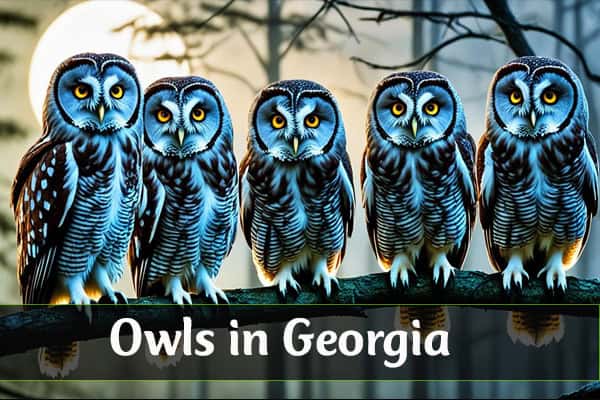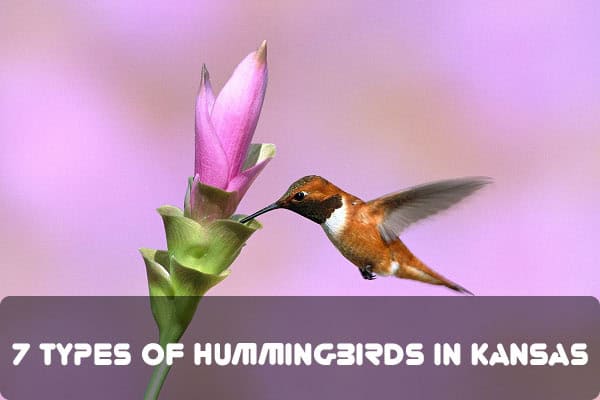8 White Birds in Florida (With Pictures)
Have you ever spotted those elegant white birds in Florida? Besides its stunning white-sand beaches and thrilling theme parks, Florida boasts a vibrant nightlife, luxurious cruising, and much more. Moreover, it attracts over 125 million visitors every year. Additionally, Florida is not only a dream vacation spot but also a haven for bird lovers. It hosts an incredible variety of over 500 bird species, making it a top birding destination in North America.
Among this diverse bird population, let’s explore some captivating white-colored birds in this article. While some birds reside in Florida year-round, others migrate here annually, making it a hotspot for birdwatchers worldwide. With Florida being home to ten distinct white bird species, some of which fly south for the winter, it’s no wonder why bird enthusiasts flock to this state. So, before you head out with your binoculars, take a moment to read through this article for quick identification tips!
1. Snowy Egret (Egretta thula)
The Snowy Egret, a petite and brilliantly white egret, is indigenous to the Americas, residing in both North and South America. Its population includes both resident individuals and migratory ones.
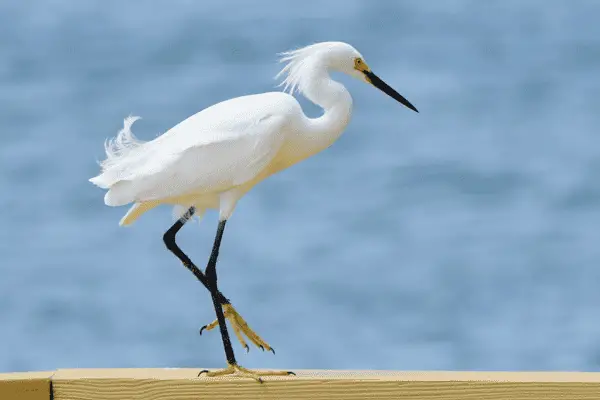
During the summer breeding season, migratory Snowy Egrets from central North America and the northeastern coast journey southward to Mexico, the southern United States, Central America, and South America. Meanwhile, those inhabiting South America, coastal Central America, coastal Mexico, and coastal southeastern United States remain within their breeding territories year-round.
Sporting a sleek, elongated black beak, striking yellow eyes, and contrasting black legs with yellow feet, Snowy Egrets boast a distinctive appearance. A notable feature is the yellow patch adorning their faces, which transitions to a reddish hue during the breeding period. Additionally, they develop long plumes extending from their head, neck, chest, and back when donned in breeding attire.
These elegant birds frequent a variety of habitats, including beaches, wetlands, estuaries, marshes, ponds, tidal pools, shallow bays, mudflats, wet fields, rivers, and lake shores.
Snowy Egrets are primarily piscivorous, foraging in shallow waters to capture fish. However, they occasionally diversify their diet by consuming insects, frogs, crustaceans, worms, and reptiles.
2. American White Pelican (Pelecanus erythrorhynchos)
The American White Pelican, an imposing black-and-white avian, boasts a lengthy beak and a predominantly white body adorned with black flight feathers and wing tips. Its striking appearance is further accentuated by the colossal orange beak, legs, and feet, complemented by a yellow patch encircling each whitish-yellow eye.
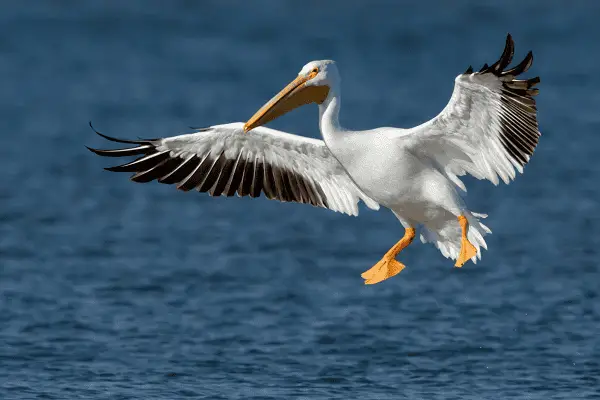
During the breeding season, these pelicans exhibit a distinctive short yellow crest and a vertical yellow plate on the upper mandible. Conversely, in the non-breeding months, the crest transitions to gray, while the bill and legs assume a yellower hue, and the plate is absent.
Primarily migratory, American White Pelicans spend their summer breeding season in the central regions of North America before embarking on a winter migration to the southern United States, Mexico, and Central America. However, individuals residing in Mexico and Texas remain sedentary throughout the year.
During the summer months, these majestic birds inhabit freshwater lakes, shallow wetlands, marshes, and river edges. In winter, they gravitate towards coastal bays, estuaries, and swamps.
Their diet primarily comprises fish, although they also supplement their meals with crayfish and amphibians.
3. Cattle Egret (Bubulcus ibis)
The Cattle Egret boasts a wide global presence, spanning Africa, Europe, Asia, Australia, and the Americas, including numerous islands. While originally native to Africa, Asia, and southern Europe, this small egret species has since expanded its range extensively.

Distinguished by its white plumage, pointed yellow beak, and yellow eyes, the Cattle Egret undergoes striking transformations during the breeding season, featuring salmon hues on the head and chest, a vibrant yellow-orange beak, and long golden-yellow plumes cascading from various parts of its body. Their leg coloration also varies, appearing black outside of breeding and transitioning to yellow or red during breeding.
In terms of diet, these adaptable birds primarily prey on insects but also consume a diverse array of prey, including spiders, ticks, fish, mammals, birds, earthworms, crustaceans, lizards, and frogs. Their name stems from their tendency to trail behind cattle and other large mammals, seizing insects disturbed by these animals.
Preferring dry habitats such as grasslands, fields, pastures, wetlands, and agricultural areas, Cattle Egrets are predominantly non-migratory across their range. However, individuals residing in the central and northern regions of the United States undertake seasonal migrations to Mexico and Central America during the winter months.
4. American White Ibis (Eudocimus albus)
The American White Ibis stands out as one of the prominent white birds with elongated beaks found in Florida, along with coastal regions of the southeastern United States, Mexico, Central America, and northern South America. While predominantly resident, some individuals undertake migration southward during winter.
These sizable wading birds feature white plumage, complemented by a long beak tipped with dark red, pinkish-red legs, blue eyes encircled by red skin, and distinctive black wing tips.

Inhabiting a variety of wetland habitats such as saltwater and freshwater marshes, estuaries, swamps, ponds, and mangroves, American White Ibises occasionally venture into parking lots and parks.
5. Little Blue Heron (Egretta caerulea) – Juvenile
The juvenile Little Blue Heron undergoes a striking transformation compared to its adult counterparts. While adults display a distinctive bluish-gray and purple plumage, juveniles are characterized by their white appearance.
Juvenile Little Blue Herons also feature dark wingtips, dull greenish legs and feet, gray or green lores, yellow eyes, and a beak adorned with black and blue-gray hues.
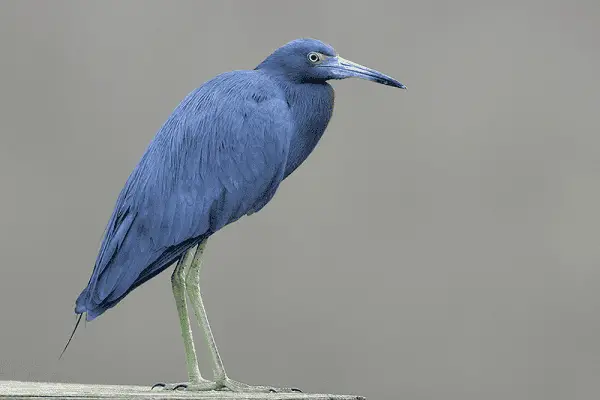
Furthermore, This species is distributed across the southeastern United States & Mexico, Central America, and South America.
Little Blue Herons exhibit partial migration tendencies. Individuals breeding in inland regions of the southeastern United States migrate to Central and South America during winter, while those inhabiting coastal areas of the southeastern United States, Mexico, and South America remain residents.
6. Great Egret (Ardea alba)
Great Egret, a towering white bird with a lengthy beak, boasts a striking appearance characterized by its white plumage, elongated neck, large yellow beak, yellow eyes, and contrasting black legs and feet.
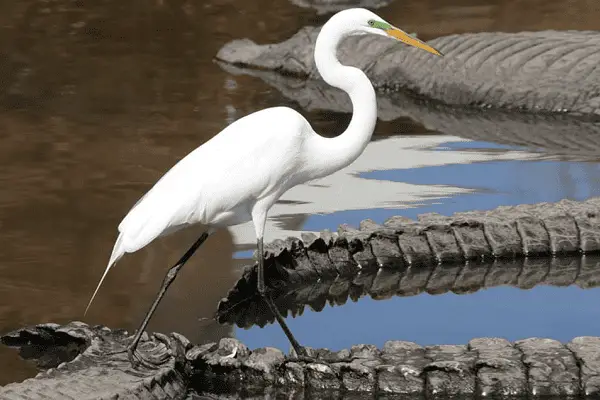
During the breeding season, the beak undergoes a color transformation, turning black in most regions but retaining its yellow hue in the Americas. Additionally, breeding Great Egrets develop long plumes extending from their backs, while their facial skin typically transitions from yellow to green.
This species thrives in diverse habitats, including wetlands, ponds, marshes, mudflats, estuaries, mangroves & flooded fields, tidal pools, swamps, streams, lakes, rivers, and other areas with standing water.
More, this fish as their primary food source, Great Egrets also consume amphibians, crustaceans, reptiles, birds, small mammals, worms, and insects.
The Great Egret boasts a widespread distribution across the Americas, Asia, Africa, Europe, Australia, and New Zealand. While resident in most regions, particularly in the southern hemisphere, it exhibits migratory behavior in the northern parts of its range. North American populations migrate from southern Canada and the United States to Central America, although individuals residing in the southern United States typically remain year-round.
7. Reddish Egret (Egretta rufescens) – White Morph
The Reddish Egret, a charming and reasonably large egret, exhibits two distinct color morphs, with our focus here on the less common white morph.

Sporting a plain white body, grayish legs and feet, pale yellow eyes, and a two-toned beak with dark coloring near the tip and a pinkish base, the white morph of this species presents a unique and elegant appearance.
Found predominantly in coastal habitats such as mudflats, salt pans, lagoons, salt marshes, and ponds, the Reddish Egret favors environments rich in aquatic resources.
While their diet primarily consists of small fish, they occasionally supplement their meals with crab, shrimp, insects, and frogs.
This species is distributed across the southern United States, Mexico, Central America, and northern South America.
Resident in most parts of its range, some Reddish Egrets in the northern regions migrate southward during winter months.
8. Masked Booby (Sula dactylatra)
The Masked Booby is a remarkable sea bird that inhabits vast expanses of the world’s tropical oceans, including the Indian, Pacific, and Atlantic Oceans which is impressive.
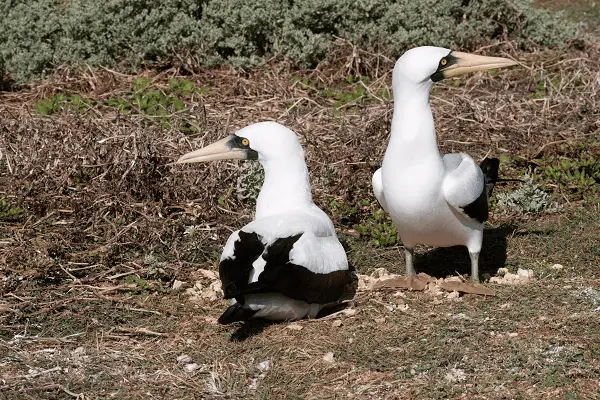
Adult Masked Boobies showcase a striking appearance with their predominantly white plumage, complemented by a distinctive black face mask, black flight feathers on the wings, and a black tail. They also feature a sizable yellow beak, yellow eyes, and pale olive or yellow legs and feet.
Typically, these birds are observed on the open ocean, but they nest on flat tropical islands.
Their diet primarily comprises fish and squid, which they capture by diving into the water.
Frequently Asked Questions:
Q1. What is the name of the white bird in Florida?
The white birds in Florida include species like the Great Egret, Snowy Egret, and White Ibis.
Q2. What are the white seabirds in Florida?
White seabirds commonly found in Florida include species such as the White Pelican and the Magnificent Frigatebird.
Q3. What are the skinny white birds in Florida?
The skinny white birds in Florida are often referred to as herons or egrets, such as the Great Egret and the Snowy Egret.
Q4. What is Florida’s most common bird?
The Northern Mockingbird is often considered Florida’s most common bird.



